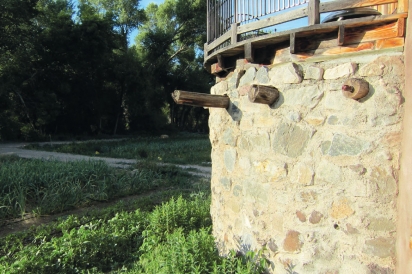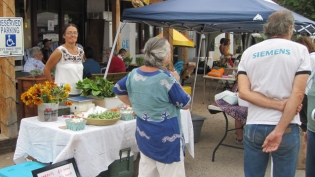Meet Stanley Crawford of Dixon NM
Ancient irrigation system nourishes small farms and community
Stanley Crawford has made Dixon, New Mexico, known far beyond its 900 people and the short, narrow valley of the Rio Embudo that the village straddles, just off NM Highway 68 an hour north of Santa Fe and half an hour south of Taos in the foothills of the Sangre de Cristo Mountains. His 1988 memoir Mayordomo: Chronicle of an Acequia in Northern New Mexico portrays a year of maintaining Dixon’s acequias, or water ditches, a communal irrigation system developed by Moors and adopted by the Spanish in the Old World and the New, and Crawford’s role as mayordomo, or boss.
His 1992 memoir A Garlic Testament: Seasons on a Small New Mexico Farm reflects on his becoming part of the Dixon community, arriving in 1969 as a successful young novelist with his Australian wife, Rose Mary, infant son, and a daughter on the way. Fresh from sojourns in parts of Europe and then San Francisco, they were spurred by the political turmoil of the time to “head for the hills,” Crawford writes, and so they found themselves in Dixon, buying two acres, making adobe bricks and building their house while also learning to grow garlic for a livelihood.
The Crawfords named their farm El Bosque Garlic Farm for the wooded lane along the Rio Embudo’s north bank that leads to it. Their main venue has been the Santa Fe Farmers Market since the 1970s, about the time I began spending part of the summer in Taos and Santa Fe, drawn by hiking trails and local farms and food.
Early on, Stan and Rose Mary’s garlic and shallots caught my eye, partly because I’d never seen either in such abundance but also because Rose Mary creates elegant garlic sculptures by clustering several heads and their long stems into a sort of upside-down nosegay, binding the stems together with coils of yarn and gently twisting the flowering ends into shapes suggesting the slender, extended necks of egrets. Smitten by the beauty and flavor of their produce, I became a regular seasonal customer.
Both their farm and Dixon came alive for me beyond Crawford’s books when I began making occasional forays to the farm on Friday afternoons, the day the Crawfords invite the public to buy produce they’ve harvested for next morning’s market. Typical of small farms, theirs is intensely worked, from planting to irrigating to weeding to harvesting to feeding the soil with compost. Yet calmness prevails, as the sound of the Embudo flowing in its rocky bed only a hundred yards to the south is a constant, soothing presence, following you past rows of garlic, shallots and other vegetables and on to the washing and packing tables to make your purchases and chat with the Crawfords.
Like most places, Northern New Mexico has suffered many ill effects from economic development. Yet it remains one of the few areas in the U.S. where the infrastructure of small-scale farming hasn’t been destroyed. A key factor in this, Crawford observes in his 2003 essay collection The River in Winter, is the preservation of acequia traditions in once-isolated Hispanic villages and Native American pueblos.
He credits acequia activists (and he is one) with thwarting “the adjudication of water rights, a process by which Spanish water law, which binds land and water together, is replaced by American water law, which separates land from water, allowing water to ‘flow uphill to money’ so that it can fuel municipal-industrial development.”
Another factor in preserving small-scale farming, Crawford says, has been the rise of farmers markets, beginning in the early 1970s in Santa Fe, Los Alamos and Taos, which “encouraged a whole new generation of small farmers to stay on the land—or return to it and to the water that is still in the acequias to irrigate their fields.”
Dixon, a patchwork of small farms and other small businesses, is a place where the fruits of activists’ labors are visible. It probably has the largest concentration of organic farmers in New Mexico, and while many sell at the year-round Santa Fe Farmers Market, some sell at the small, summer Dixon Farmers Market, offering a great variety of vegetables, herbs, flowers and fruits.
A number of Dixon growers also help supply the Dixon Cooperative Market, a grocery purveying local produce and national-brand foods. Established in 2005, it has more than doubled its original space, and, with a deli inside and a covered deck and tables outside, it’s Dixon’s main gathering place. You can buy the New York Times there every day, along with local papers, and you can sit, eat and chat, sometimes to live music. Dixon is also home to two vineyards and wineries, La Chiripada and Vivác, each with a tasting room drawing visitors daily.
The town’s agricultural and cultural bounty is perhaps most fully evident during the annual Dixon Studio Tour each November. Farmers open their farms, and artists—potters, painters, weavers, wood workers and such—open their studios to the public. Day-trippers come by the hundreds, and overnighters fill the rental lodging, including a guesthouse at the Crawfords’.
If you like getting your hands in the dirt, an annual event that might appeal to you is the Crawfords’ several-day garlic harvest in late June. Volunteers arrive at 8am and join farm employees in following Crawford’s instructions. A day or so ahead, he uses a chisel plow to loosen the plants from the soil, and it’s the volunteers’ task to pull and bunch the plants and then pile the bunches evenly on a wooden rack attached to Crawford’s tractor. You follow the tractor to the shed and place the garlic on drying racks, and return to the field to pull and bunch some more. The Crawfords provide snacks and lunch, everyone provides camaraderie, and you get to take home some garlic—a savory memento, a taste of El Bosque Garlic Farm, of the Crawfords’ husbandry and hospitality and of Dixon’s earthy and watery embrace.








